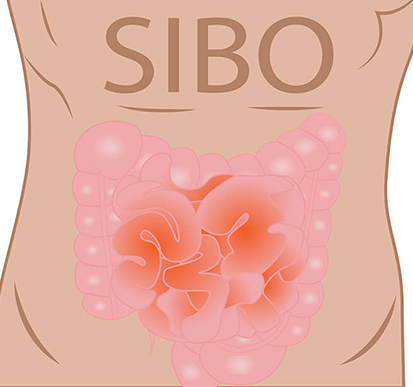
What is SIBO?
While SIBO (Small Intestinal Bacteria Overgrowth) has been written about since the early 1990’s it is only in the last 10 years that it has reached people’s awareness with more than 500 scientific publications on the topic in the last 5 years. SIBO is a relatively common gut disorder found between 2 to 6% of healthy controls (no gut issues) and as high as 90% in groups reporting gut health issues. SIBO has been reported in 33% in people with unexplained bloating, gas, and pain, 24.5% of patients with IBS, and 17.1% of obese individual compared to 2.5% in healthy subjects. In one study SIBO was identified in 31.5% patients under 19 years of age with GI conditions. In another study 72.2% of overweight children tested positive for SIBO while children with chronic abdominal pain (CAP), which accounts for approximately 25% of paediatric gastroenterology office visits, 91% tested positive for SIBO. SIBO was also detected in 50% of patients using Proton Pump Inhibitor’s (PPI’s) for reflux. Which is one of the many reasons I encourage people no to take these drugs.
SIBO is considered to be an excessive increase in the number of bacteria (or fungi-SIFO) in the microbial flora in the small intestine (the duodenum, the jejunum, and the ileum). Normally there are low numbers of these microorganisms due to the pH of the stomach and small intestine and certain antibacterial agents released by our gut, so when the numbers increase or the wrong type of microorganisms grow, fermentation (anaerobic breakdown) of the undigested foods in the small intestine produces hydrogen, methane and carbon dioxide gases.
Normally the foods are broken down through digestion which is the chemical breakdown of foods such as carbohydrates, with enzymes from our own body. This occurs through the enzymes we find naturally occurring in foods and those released in saliva, the stomach (mainly for proteins) and small intestine. The enzymes break the carbohydrates down to their constituent components which can then be absorbed through into the blood from the small intestine. If these carbohydrate molecules are not digested they can become food for fermentation. Fermentation in the microbial breakdown of foods (not normally human cells).
Typical symptoms of SIBO include
It may also manifest as
On a global scale it has recently been implicated in stunting, a disease that affects millions of children worldwide as it is prevalent among children living in low-income settings, leading to impaired growth and development. Children and adolescents with SBIO associated with diseases of the gastrointestinal tract have lower weight and height values. It is also an important and under-recognized clinical syndrome in the elderly. It is the most common cause of malabsorption among older adults.
Part 2 in the next newsletter
or
Our 4 part SIBO Solution Masterclass is now available in our membership program
References:
Front Pediatr . 2019 Sep 4;7:363. doi: 10.3389/fped.2019.00363. eCollection 2019. Small Intestinal Bacterial Overgrowth in Children: A State-Of-The-Art Review David Avelar Rodriguez 1 , Paul MacDaragh Ryan 2 , Erick Manuel Toro Monjaraz 1 , Jaime Alfonso Ramirez Mayans 1 , Eamonn Martin Quigley 3 PMCID: PMC6737284 DOI: 10.3389/fped.2019.00363
Am J Trop Med Hyg . 2019 Jan;100(1):222-225. doi: 10.4269/ajtmh.18-0759. Impact of Small Intestine Bacterial Overgrowth on Response to a Nutritional Intervention in Bangladeshi Children From an Urban Community S M Abdul Gaffar 1 , Shafiqul Alam Sarker 1 , Mustafa Mahfuz 1 , Jeffrey R Donowitz 2 , Tahmeed Ahmed 1 PMCID: PMC6335917 DOI: 10.4269/ajtmh.18-0759
Rev Paul Pediatr . 2020 Jan 13;38:e2018164. doi: 10.1590/1984-0462/2020/38/2018164. eCollection 2020. THE IMPACT OF SMALL INTESTINAL BACTERIAL OVERGROWTH ON THE GROWTH OF CHILDREN AND ADOLESCENTS Alexandre Neves da Rocha Santos 1 , Ana Cristina Fontenele Soares 1 , Ricardo Palmero Oliveira 1 , Mauro Batista de Morais 1 PMCID: PMC6958541 DOI: 10.1590/1984-0462/2020/38/2018164
Geriatrics . 2006 Sep;61(9):21-6. Small Bowel Bacterial Overgrowth. An Underrecognized Cause of Malnutrition in Older Adults Heather L Elphick 1 , David A Elphick, David S Sanders
Aliment Pharmacol Ther . 2013 Oct;38(7):674-88. doi: 10.1111/apt.12456. Epub 2013 Aug 20. Review article: small intestinal bacterial overgrowth–prevalence, clinical features, current and developing diagnostic tests, and treatment E Grace 1 , C Shaw, K Whelan, H J N Andreyev DOI: 10.1111/apt.12456
Dig Dis Sci Actions. 2020 May;65(5):1405-1413. doi: 10.1007/s10620-019-05889-9. Epub 2019 Oct 15. Diagnostic Utility of Carbohydrate Breath Tests for SIBO, Fructose, and Lactose Intolerance Mercedes Amieva-Balmori 1 2 , Enrique Coss-Adame 1 3 , Nikilesh S Rao 1 , Brisa M Dávalos-Pantoja 1 , Satish S C Rao 4 DOI: 10.1007/s10620-019-05889-9
Clin Gastroenterol Hepatol Actions. 2010 Jun;8(6):504-8. doi: 10.1016/j.cgh.2009.12.022. Epub 2010 Jan 6. Increased incidence of small intestinal bacterial overgrowth during proton pump inhibitor therapy Lucio Lombardo 1 , Monica Foti, Olga Ruggia, Andrea Chiecchio DOI: 10.1016/j.cgh.2009.12.022
Obes Surg Actions. 2008 Apr;18(4):371-7. doi: 10.1007/s11695-007-9398-2. Epub 2008 Feb 20. High prevalence of small intestinal bacterial overgrowth in patients with morbid obesity: a contributor to severe hepatic steatosis Jean-Marc Sabaté 1 , Pauline Jouët, Florence Harnois, Charlotte Mechler, Simon Msika, Maggy Grossin, Benoît Coffin DOI: 10.1007/s11695-007-9398-2
Front Pediatr Actions. 2020 Jul 7;8:369. doi: 10.3389/fped.2020.00369. eCollection 2020. Role of Small Intestinal Bacterial Overgrowth (SIBO) and Inflammation in Obese Children Susanna Esposito 1 , Anna Biscarini 2 , Barbara Federici 3 , Marta Cofini 2 , Alberto Argentiero 1 , Cosimo Neglia 1 , Lucia Lanciotti 2 , Gian Luigi De’ Angelis 3 , Nicola Principi 4 5 PMCID: PMC7358338 DOI: 10.3389/fped.2020.00369
Dig Dis Sci Actions. 2010 Jan;55(1):124-30. doi: 10.1007/s10620-009-1026-7. Chronic abdominal pain in children is associated with high prevalence of abnormal microbial fermentation Brynie Slome Collins 1 , Henry C Lin DOI: 10.1007/s10620-009-1026-7